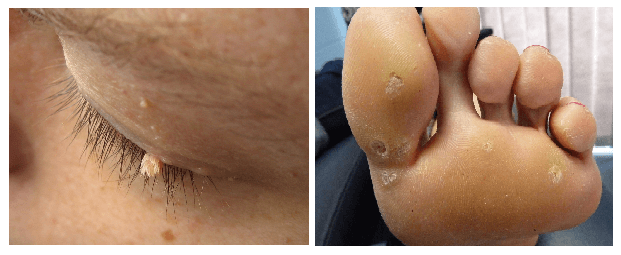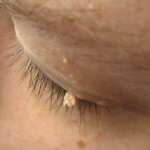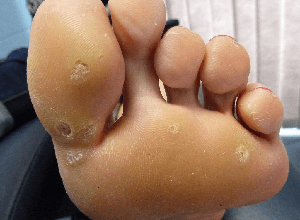After comparing Sking tags vs Moles, in this post, we are going to compare Skin Tags Vs Warts. You will get to know how Skin Tags are different from Skin Warts.
We all fantasize about having flawless porcelain skin; I know I do! The reality, however, hinges on a number of issues including genes, the environment, and health. Wherefore any of the above factors or just plain old “bad luck” can cause you to have skin imperfections like warts and skin tags.
Skin Tags Vs Wart – Detailed Comparison
Warts and skin tags are widely similar. Why bother to know the difference? While for the most part, they remain harmless, some warts are an indicator of a serious underlying issue. It is important, therefore, to understand the difference between the two.
Skin Tags: What are they?
Skin tags are tiny, soft, body-colored protrusions that hang off the skin by a stalk. They vary from string-like shape to balloon-shaped growths. Often, skin tags are barely visible but other times, they can grow up to 5cm long. The tiny stalk that connects the skin tag to the body is known as a peduncle.
Skin tags are painless and benign. Science pegs skin tags as being malignant. Very rarely have skin tags been diagnosed as cancerous. They are made up of detached collagen fibers and tiny blood capillaries in a bag of skin. Collagen is the most common type of naturally occurring protein in our bodies.
Scientifically, skin tags are referred to as acrochordon, cutaneous papilloma, fibroepithelial polyp, or soft fibroma.
Where do they occur?
You may have noticed that skin tags are prominent on the neck, armpits, groin folds, buttock folds, eyelids, thighs and under the breasts. This is because skin-to-skin or skin-to-cloth friction encourages the appearance of skin tags.
They tend to favor anyone above the age of 50 years, people who suffer from obesity and type 2 diabetes, and pregnant mothers in the 2nd trimester. Children rarely have skin tags unless they are overweight.
Skin Warts: What are they?
Warts are small, solid and often raised growths on the skin. Their top surface is coarse and resembles a cauliflower. Warts vary in appearance depending on where on the body they appear and the thickness of the skin in that area. You may not notice your wart especially because it is painless and similar in color to your flesh.
Cause of warts
Warts occur when the Human Papillomavirus (HPV) enters the skin through a damaged cell. The outer layer of skin is loaded with keratin. Keratin is a naturally occurring hard protein. When HPV interacts with damaged skin, the Keratin in the skin causes cells to grow rapidly resulting in a wart.
Warts are common among people with low immunity. These include people with HIV/AIDS and those using immune-suppressants, especially after a transplant procedure. Butchers are also at a high risk of having warts due to handling raw meat. Children are prone to warts because their immune system is not fully developed. People who use public swimming pools, showers and share towels and other personal effects are likely to contract warts from each other.
Are warts contagious?
Warts are highly contagious which is why it is important to be vigilant about the elements that may cause them to spread.
- Do not pick on them. Once you handle your wart, wash your hands with soap and water to avoid transferring the wart to other parts of your body.
- Be careful when shaving around a wart. The shaver is capable of transferring the HPV to other areas.
- Always wear slippers or flip-flops when walking around or using public bathrooms and swimming pools.
- Do not share towels or allow skin-to-skin contact with someone who has warts.
Types of warts
There are several types of warts.
Plantar warts commonly appear on the soles of feet, balls of the toes or the heels. They are brought about by pressure on those points due to weight. For the most part, they are not raised, rather they are a hard surface with a dark dot at the middle. The dot is a severed or clotted vein.
1. Palmer warts are the most common warts. They occur anywhere on the body and have the typical raised rough surface.
2. Flat warts are also known as plane warts. They are caused by exposure to the sun. Plane warts occur in clusters and often disappear without treatment. They’re common on the face, hands, neck, knees, and wrists.
3. Genital warts are as the name suggests. They affect the genitalia and are highly contagious. These need to be treated because they can lead to cervical, anal, and vulvovaginal cancer in women, and anal cancer or glans penis disease in men.
4. Filiform warts are also known as digitate warts. They are long, thin, soft, and resemble a grain of rice. You are likely to find them on eyelids, lips, neck, and armpits.
5. Mosaic warts and Periungual warts both occur in clusters on the hands, feet, and around the nails. They are completely harmless and painless unless infected.
You may like to read,
3 Best Skin Tags & Wart Removal Creams
What Causes Moles to Suddenly Appear Reasons, Types, Prevention
DermaBellix Review [Mole, Tag Remover]- The key to flawless skin
Warts Vs Skin Tags: Which are more dangerous?
Skin tags and warts are largely harmless. They both disappear on their own without the need for medication. Nonetheless, it is important to visit a dermatologist whenever you notice a growth of any kind. This is because dire conditions like cancers often start with similar growths. Genital warts must be treated because they have the potential to develop into cancer.
Warts Vs Skin Tags: Treatment
If the dermatologist clears you as having a wart or skin tag and you want to get rid of it, consider using the Skincell cream. Skincell cream is a dermatological product known for clearing skin tags and warts from the skin.
Taking care of your body is imperative in order to have healthy-looking skin. Even though some imperfections are impossible to prevent, you can still have beautiful skin, warts and all.


